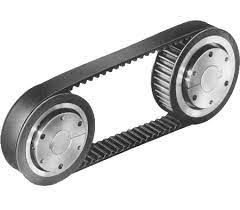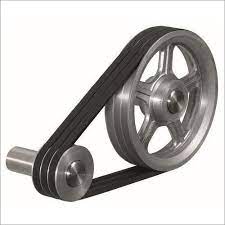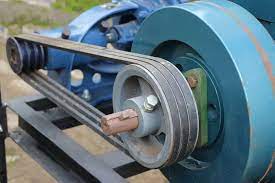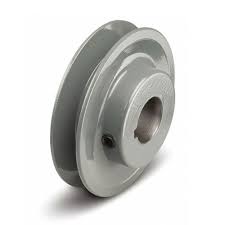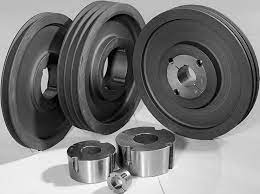Product Description
Drive Pulley/Belt Conveyor Pulley/Tail Pulley
Type of Conveyor Pulley:
Conveyor tail pulley
Conveyor head pulley
Conveyor rubber lagging pulley
Conveyor steel pulley
Conveyor driving pulley
Conveyor turnaround pulley
Pattern conveyor pulley
Conveyor pulley
Rubber conveyor pulley
Head pulley etc.
Conveyor Head Tail pulley:
Head pulley can be divided into driving pulley (head pulley) and thurn about pulley (tail pulley), driving pulley is the main part for transmitting the power: Smooth surface and rubber surface, and rubber surface can be classified into smooth rubber surface, herringbone rubber surface and CHINAMFG rubber surface to meet different technical requirements. Averting pulley can be classified into smooth rubber surface and smooth steel surface.
Construction
All the pulley adopt integrated bearing housing which is lubricated and filled with grease and has 2 kinds: Iron casting and steel casting, the shaft is made of 45#steel, the shell adopt weld assembly.
CHINAMFG Conveyor Pulley Specification:
1. Pulley Diameter: 250-1800mm.
2. Belt width: 300mm to 2400mm.
3. Length: Depend on the belt width.
4. Welding: Carbon dioxide arc welding, argon arc welding, electrode welding etc.; In accordance with AWS standard or substitute welding standard
5. Lagging: Cold lagging; Hot vulcanized lagging, ceramic lagging
6. Pulley tube material: Q235 seamless carbon steel.
7. Professional pulley production line.
8. Professional designing and inspection team.
9. Certification: ISO, BV, etc
Our best quality based on:
Manufacturer
Experience in Cooperate with Fortune 500 Companies
Professional Engineering Capability
Stable Quality
Reasonable Price
Small Orders Accepted
Continuous Improvements
High Product Performance
Prompt Delivery
Professional Service
For more details, please inquiry us!
Polyester conveyor belt, (EP)
Nylon conveyor belt, (NN)
Cotton conveyor belt, (CC)
Sidewall conveyor belt (SW)
Steel Cord conveyor belt ( ST )
Chevron conveyor belt, (C5 C10 and C15)
Oil Resistance conveyor belt, (OR and MOR)
Hot Resistance conveyor belt, (HR)
Fire Resistance conveyor belt, (FR/PVC/PVG)
Heat Resistance conveyor belt, (HR/ FR)
Cold Resistance conveyor belts, (CR)
Pattern conveyor belt ( 30+ Moulds)
Metal Mesh conveyor belt (Heat resistant temp until 800c)
Endless belts
Conveyor roller, idler
Conveyor Pulley, frame, bracket etc
| Type | Belt width (mm) | Standard Diameter(mm) | Length (mm) |
| Drive Head Pulley | 500 | 500 | Length of the pulley depends on the belt width of the conveyor |
| 650 | 500, 630 | ||
| 800 | 500, 630, 800 | ||
| 1000 | 630, 800, 1000 | ||
| 1200 | 630, 800, 1000 | ||
| 1400 | 800, 1000 | ||
| Tail Pulley | 500 | 250, 315, 400, 500 | |
| 650 | 250, 315, 400, 500 | ||
| 800 | 250, 315, 400, 500, 630, 800, 1000 | ||
| 1000 | 250, 315, 400, 500, 630, 800, 1000 | ||
| 1200 | 250, 315, 400, 500, 630, 800, 1000 | ||
| 1400 | 250, 315, 400, 500, 630, 800, 1000 |
/* January 22, 2571 19:08:37 */!function(){function s(e,r){var a,o={};try{e&&e.split(“,”).forEach(function(e,t){e&&(a=e.match(/(.*?):(.*)$/))&&1
| Type: | Handling Machinery |
|---|---|
| Structure: | Belt Conveyor |
| Material: | 45# Steel, Rubber and etc |
| Material Feature: | Oil Resistant |
| Color: | Available |
| Condition: | New |
| Samples: |
US$ 200/Piece
1 Piece(Min.Order) | |
|---|
| Customization: |
Available
| Customized Request |
|---|

How are drive pulleys used in the production of paper and printing machinery?
Drive pulleys play a crucial role in the production of paper and printing machinery by providing power transmission and control. They are used in various stages of the paper manufacturing process, as well as in the operation of printing presses. Here are some key ways in which drive pulleys are utilized in these industries:
1. Paper Manufacturing:
In the paper manufacturing process, drive pulleys are employed in several key steps:
- Pulping: Drive pulleys are used in pulping machines to break down raw materials, such as wood chips or recycled paper, into a pulp. The pulleys help drive the rotating blades or beaters that break down the materials.
- Paper Machine: In the paper machine, drive pulleys are used to control the movement of the paper web. They are used in the forming section to guide and control the flow of pulp onto the wire mesh, allowing water to drain and forming the paper sheet. Drive pulleys are also used in the pressing and drying sections, where they help control the tension and speed of the paper as it passes through various rollers and dryer sections.
- Reeling and Winding: After the paper has been produced, it is wound into large rolls or reels. Drive pulleys are used in the reeling and winding machines to control the tension and speed of the paper as it is wound onto the reels.
2. Printing Machinery:
In the printing industry, drive pulleys are utilized in various types of printing presses, such as offset, flexographic, and gravure presses. Here are some specific applications:
- Feeder Systems: Drive pulleys are used in the feeder systems of printing presses to control the movement of paper or other printing substrates. They help ensure a consistent and accurate feed of the material into the press.
- Impression Cylinder: The impression cylinder in a printing press is responsible for transferring the inked image from the printing plate onto the paper. Drive pulleys are used to rotate the impression cylinder, providing the necessary force for the transfer process.
- Delivery Systems: Drive pulleys are also employed in the delivery systems of printing presses to control the movement of the printed material as it emerges from the press. They help maintain proper tension and speed, allowing for smooth and precise delivery of the printed products.
Overall, drive pulleys are essential components in the paper and printing industries, enabling the efficient and controlled movement of materials throughout the production process. They contribute to the precise and reliable operation of machinery, ensuring high-quality paper production and printing output.

What role do drive pulleys play in automotive engines and accessory drive systems?
Drive pulleys play a crucial role in automotive engines and accessory drive systems, contributing to the proper functioning of various components and systems. They are responsible for transferring power from the engine to auxiliary components, such as the alternator, water pump, power steering pump, and air conditioning compressor. Here are the key roles of drive pulleys in automotive engines and accessory drive systems:
1. Power Distribution:
Drive pulleys are responsible for distributing power from the engine’s crankshaft to various accessory components in the vehicle. They are typically connected to the crankshaft by a drive belt or serpentine belt. As the engine rotates, the drive pulleys transmit rotational motion to the connected accessories, enabling them to perform their respective functions. By efficiently distributing power, drive pulleys ensure the proper operation of essential components.
2. Belt Routing:
Drive pulleys assist in determining the belt routing in automotive accessory drive systems. The pulleys are strategically positioned to guide the belt along the desired path, ensuring proper engagement with each accessory component. The correct belt routing is crucial for optimal power transfer, belt tension, and overall system performance. Drive pulleys serve as guiding mechanisms, contributing to the proper alignment and operation of the belt in the system.
3. Speed and Torque Conversion:
Drive pulleys, in conjunction with the belt or pulley size ratios, enable speed and torque conversion in automotive accessory drive systems. By varying the size ratio between the driving and driven pulleys, different speed and torque relationships can be achieved. This allows the accessories to operate at their required speeds and generate the necessary torque for their functions. Drive pulleys play a role in adapting the engine’s rotational speed and torque to match the specific requirements of each accessory component.
4. Load Management:
Drive pulleys help manage the load on the engine by driving auxiliary components only when needed. For example, the alternator is driven by a pulley that converts rotational motion into electrical energy to charge the battery and power the electrical systems. By engaging the alternator only when necessary, the load on the engine is reduced during acceleration, improving overall engine performance and fuel efficiency. Drive pulleys contribute to load management and optimize the balance between power generation and engine output.
5. System Synchronization:
In some automotive engines, drive pulleys play a role in system synchronization. For instance, engines with variable valve timing mechanisms may utilize pulleys with adjustable timing marks or teeth. These pulleys help synchronize the movement of the camshafts with the crankshaft, ensuring precise valve timing and optimizing engine performance. Drive pulleys contribute to the synchronization of critical engine components, enhancing efficiency and power output.
6. Tensioning and Belt Alignment:
Drive pulleys assist in maintaining proper belt tension and alignment in automotive accessory drive systems. Tensioning pulleys, also known as idler pulleys, are used to apply tension to the belt, ensuring it remains properly engaged with the drive and driven pulleys. Belt alignment is essential for preventing slippage, reducing wear, and maximizing power transfer efficiency. Drive pulleys, along with tensioning pulleys, help maintain optimal belt tension and alignment, contributing to the overall reliability and performance of the accessory drive system.
7. System Reliability and Serviceability:
Drive pulleys play a role in ensuring the reliability and serviceability of automotive accessory drive systems. Well-designed pulleys with durable materials and proper groove profiles minimize wear and extend the life of the drive belt. Additionally, drive pulleys are often designed for easy installation, adjustment, and replacement, simplifying maintenance tasks. This contributes to efficient servicing and reduces downtime in automotive engines and accessory drive systems.
In summary, drive pulleys are integral components in automotive engines and accessory drive systems. They facilitate power distribution, belt routing, speed and torque conversion, load management, system synchronization, tensioning, and belt alignment. By performing these roles, drive pulleys contribute to the reliable and efficient operation of auxiliary components, enhancing the overall performance of automotive engines.

How do drive pulleys contribute to the efficient transmission of power?
Drive pulleys play a crucial role in ensuring the efficient transmission of power in various mechanical systems. Their design and function enable the transfer of rotational motion and torque from a driving source, such as an engine or motor, to driven components, such as belts, chains, or shafts. Here’s how drive pulleys contribute to the efficient transmission of power:
1. Power Transfer:
Drive pulleys provide a mechanical interface between the driving source and the driven components. They transmit power from the driving source to the driven components, allowing them to perform their intended functions. By maintaining a solid connection and effective power transfer, drive pulleys minimize energy losses and maximize the efficiency of the system.
2. Speed and Torque Conversion:
Drive pulleys are often used in conjunction with belts or chains to convert speed and torque between the driving source and the driven components. By varying the size ratio between the driving and driven pulleys, different speed and torque relationships can be achieved. This allows for the adaptation of power output to meet the specific requirements of the driven components, optimizing efficiency and performance.
3. Mechanical Advantage:
Drive pulleys can provide mechanical advantage in power transmission systems. By utilizing different-sized pulleys or multiple pulley arrangements, such as pulley systems with multiple belts or chains, the mechanical advantage can be increased. This enables the driving source to exert a greater force or torque on the driven components, enhancing efficiency and enabling the handling of higher loads or resistance.
4. Belt Tension and Grip:
In belt-driven systems, drive pulleys contribute to efficient power transmission by maintaining proper belt tension and grip. The design of the pulley rim, such as V-grooves or toothed profiles, ensures optimal engagement with the belt, preventing slippage and ensuring efficient power transfer. By effectively gripping the belt, drive pulleys minimize energy losses due to slipping or excessive friction, thereby improving overall efficiency.
5. Alignment and Stability:
Drive pulleys help maintain proper alignment and stability in power transmission systems. They guide the movement of belts, chains, or shafts, ensuring that they remain in the desired position and track correctly. Proper alignment reduces friction and wear, minimizing energy losses and improving the overall efficiency of the system. Additionally, stable and well-supported drive pulleys prevent vibrations and misalignment, which can lead to decreased efficiency and increased wear.
6. Load Distribution:
Drive pulleys distribute the transmitted power evenly across the system. They help distribute the load or force exerted by the driving source to the driven components, ensuring balanced power transmission. This balanced load distribution minimizes stress concentrations and prevents premature wear or failure of system components, contributing to overall efficiency and longevity.
7. Maintenance and Serviceability:
Efficient power transmission is also facilitated by the maintenance and serviceability features of drive pulleys. Properly designed pulleys allow for easy installation, adjustment, and replacement of belts, chains, or other driven components. This simplifies maintenance tasks, reduces downtime, and ensures that the system operates at its optimal efficiency over its lifespan.
In summary, drive pulleys contribute to the efficient transmission of power by providing a reliable mechanical interface, enabling speed and torque conversion, offering mechanical advantage, maintaining belt tension and grip, ensuring alignment and stability, distributing loads evenly, and facilitating maintenance and serviceability. By optimizing power transfer and minimizing energy losses, drive pulleys enhance the overall efficiency and performance of mechanical systems.


editor by CX
2024-05-17

